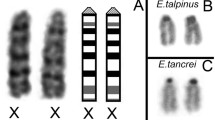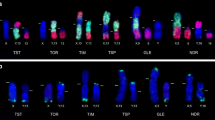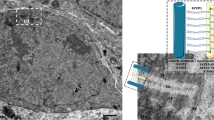Abstract
The sex vesicle-autosomal complex of mice heterozygous for Searle's X-autosome translocation has been reconstructed by serial sectioning and model building. The chromosomal axes of the five reconstructed models showed a characteristic pattern. The four axes present were identified as corresponding to: an unchanged autosome (A1), the Y chromosome (Y) and the two translocation products, Xt, that has the X centromere, and A2t that has an autosomal centromere. The axes of these translocated chromosomes have a mixed path, inside the sex vesicle and autosomal chromatin. The axes pair among themselves according to a pattern which agrees with that predicted by Ford and Evans (1964). It has been shown that the pairing region of the X chromosome of mice is the distal region and that the nucleolus is attached near its centromeric region. In some cells a slightly different pattern of the axes (type B) was observed. These cells have an anomalous synaptonemal complex between A2t and Xt, that is, between portions of the X axis. It has been shown that autosomal chromatin becomes heteropycnotic in the proximity of the X−Y chromatin, and that this effect is stronger in the proximal part of A2t. This effect explains the enlarged volume of the sex vesicle.
Similar content being viewed by others
References
Ford, C. E., Evans, E. P.: A reciprocal translocation in the mouse between the X chromosome and a short autosome. Cytogenetics 3, 295–305 (1964).
La Cour, L. F., Wells, B.: Chromocentres and the synaptonemal complex. J. Cell Sci. 6, 655–667 (1970).
Lyon, M. F., Searle, A. G., Ford, C. E., Ohno, S.: A mouse translocation suppressing sex-linked variegation. Cytogenetios 3, 306–323 (1964).
Moens, P. B.: The structure and function of synaptinemal complexes in Lilium longiflorum sporocytes. Chromosoma (Berl.) 23, 418–451 (1968).
Moses, M. J.: Chromosomal structures in crayfish spermatocytes. J. biophys. biochem. Cytol. 2, 215–218 (1956).
—: Synaptinemal complex. Ann. Rev. Genetics 2, 363–412 (1968).
-: Structure and function of the synaptonemal complex. In: Nuclear physiology and differentiation. Genetics, Suppl. 61, 41–51 (1969).
Ohno, S., Kaplan, W., Kinosita, R.: Heterochromatic regions and nucleolus organizers in chromosomes of the mouse Mus musculus. Exp. Cell Res. 13, 358–364 (1957).
—, Lyon, M. F.: Cytological study of Searle's X-autosome translocation in Mus musculus. Chromosoma (Berl.) 16, 90–100 (1965).
Reader, C., Solari, A. J.: The histology and cytology of the seminiferous epithelium of the mouse with Searle's X-autosome translocation. Acta physiol. lat.-amer. 19, 249–256 (1969).
Russell, L. B.: Mammalian X-chromosome action: Inactivation limited in spread and in region of origin. Science 140, 976–978 (1963).
—, Montgomery, C. L.: Comparative studies on X-autosome translocations in the mouse. II. Inactivation of autosomal loci, segregation and mapping of autosomal breakpoints in five T(X;I)'s. Genetics 64, 281–312 (1970).
Searle, A. G.: Is sex-linked Tabby really recessive in the mouse? Heredity 17, 297 (1962).
Solari, A. J.: The morphology and the ultrastructure of the sex vesicle in the mouse. Exp. Cell Res. 36, 160–168 (1964).
—: The evolution of the ultrastructure of the sex chromosomes (sex vesicle) during meiotic prophase in mouse spermatocytes. J. Ultrastruct. Res. 27, 289–305 (1969a).
-: Changes in the sex chromosomes during meiotic prophase in mouse spermatocytes. In: Nuclear physiology and differentiation. Genetics, Suppl. 61, 113–120 (1969b).
—: The spatial relationship of the X and Y chromosomes during meiotic prophase in mouse spermatocytes. Chromosoma (Berl.) 29, 217–236 (1970a).
—: The behaviour of chromosomal axes during diplotene in mouse spermatocytes. Chromosoma (Berl.) 31, 217–230 (1970b).
-: The behaviour of chromosomal axes during male meiosis in mammals. In: Conference on the regulation of mammalian reproduction. Bethesda, 1970 (in press, 1971).
Sotelo, J. R.: Ultrastructure of the chromosomes at meiosis. In: Handbook of molecular cytology (A. Lima-de-Faria, ed.), p. 412. Amsterdam: North Holland Publ. Co. 1969.
Wolstenholme, D. R., Meyer, G.: Some facts concerning the nature and formation of axial core structures in spermatids of Gryllus domesticus. Chromosoma (Berl.) 18, 272–286 (1966).
Woollam, D. H., Ford, E. H.: The fine structure of the mammalian chromosome in meiotic prophase with special reference to the synaptinemal complex. J. Anat. (Lond.) 98, 163–173 (1964).
Author information
Authors and Affiliations
Rights and permissions
About this article
Cite this article
Solari, A.J. The behaviour of chromosomal axes in Searle's X-autosome translocation. Chromosoma 34, 99–112 (1971). https://doi.org/10.1007/BF00285520
Received:
Accepted:
Issue Date:
DOI: https://doi.org/10.1007/BF00285520




